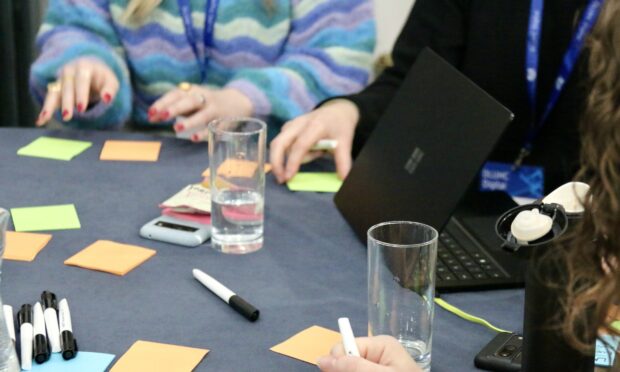
Delivery managers are accountable for the delivery of products and services. Due to the dynamic and demanding nature of their jobs, they face unique challenges. They’re often experience-rich but time-poor, which may limit their ability to get involved in a community of practice.
To address these challenges and foster collaboration, we have established a forward-thinking working practice for our community of practice, specifically tailored to the needs of delivery managers.
In this blog post, we will shed light on our innovative approach to asynchronous working, and illustrate how we’ve used it to improve our community onboarding process.
What is a community of practice?
A community of practice is a group of individuals who work in the same specialism and come together to learn, collaborate, share good practice and develop their expertise. Within DLUHC Digital, we have several communities of practice that cater to different roles and disciplines, such as technology, product, user-centred design, business analysis, and, of course, delivery.
Our unique asynchronous approach
As our delivery management community has grown, we have developed and started to adopt an asynchronous approach to improve collaboration and idea development.
Asynchronous working refers to a decentralised and flexible model of collaboration, where individuals or small groups contribute and engage with the community independently.
This approach recognises the time constraints of our delivery colleagues who are incredibly experienced and knowledgeable but often find it challenging to get involved in community work alongside their ‘day jobs’.
By embracing asynchronous working, we have created an environment that allows individuals to contribute at their own convenience, fostering a culture of continuous organic growth and collaboration.
Asynchronous working in our community
Asynchronous working provides the flexibility to work on relevant topics at your convenience, ensuring that valuable contributions are not limited by traditional meeting schedules.
This method respects the volatile nature of delivery management work and acknowledges the time constraints faced by our knowledge-rich, time-poor colleagues.
It also alleviates the pressure to create a 'perfect' community of practice from the outset, which has historically been a barrier to its formation and sustainability.
And it provides an opportunity to humanise interactions beyond digital platforms, encouraging direct engagement with subject matter experts who are available to assist.
A case study: community of practice onboarding process
This case study illustrates how we applied an asynchronous approach to the work of our community of practice.
1. Identifying the issue
The community of practice chose onboarding as the initial issue to address. This decision was based on a survey of our members, which highlighted onboarding as one of the main problems.
2. Tackling the issue using an asynchronous approach
The team used an asynchronous approach to collaborate. We identified the most appropriate method to allow the community of practice to work asynchronously – we considered using surveys, Word documents, spreadsheets and more.
A working group was chosen and it created a Mural board where community members could contribute requirements, pain points and potential actions related to onboarding. This allowed for gradual input and preparation ahead of a more formal session.
3. Formal session and working group
During the formal session, the team discussed and expanded upon the points identified asynchronously.
An onboarding working group was established to take ownership of the issue and provide feedback to the wider community of practice.
4. Continued transparent collaboration
Outside of the formal meeting, the onboarding working group continued to work in a shared space, ensuring transparency.
Their actions and progress were visible to the entire community of practice.
5. Deliverable: the update and the Loop page
The team’s efforts resulted in 2 deliverables:
- providing and receiving feedback at the next formal meeting (‘you said, we did’ and ‘what can we do better’)
- an updated Loop page for the community of practice. This page outlines various actions required for onboarding a new joiner. It includes information on difficulty, duration, prerequisites and subject matter experts available for advice and support
6. Ongoing ownership and feedback
The onboarding working group will continue to:
- own the process and support pages
- provide feedback to and act as the subject matter expert for the community
- support anyone wanting to become involved in the working group
Their success has led to recognition, and they’ve been asked to share their work with other groups.
The outcomes so far
As a result of doing the work outlined in the case study above, we were able to adopt this repeatable approach to engage with other communities of practice and areas of interest at DLUHC, such as Technical Toolkit (what tools are approved for use, what tools fit best to the different needs of teams and what tools we should avoid) and Team Snap (where members of the community can get together to share and develop their knowledge).
The granular approach to developing our ways of working allows for more buy-in from the community and highlights the empowerment we have in this space, the permission to take ownership and the value we bring.
An additional advantage of asynchronous working within our community of practice is the opportunity for crossovers and collaboration with other communities.
This interconnectedness enhances the exchange of ideas, best practices and expertise, resulting in a broader and more diverse learning experience for all participants.
While we continue to interact through the traditional community of practice channels – regular meet-ups and online forums – this approach can help us maximise opportunities for collaboration, which in turn can result in improved outcomes for our community.
Leave us a comment if you’re interested in finding out more about asynchronous working or if it’s something you’d like to try in your team or another community of practice. Email Dave O’Gorman.
If you work in delivery, keep an eye on our career portal for opportunities to work on exciting projects and develop your career with us.

Leave a comment